Social status often reflects an individual's influence and prestige within a community, while economic status measures financial wealth and resources. Explore the complex interplay between social and economic status in relationships in this article.
Table of Comparison
| Expectation | Social Status | Economic Status |
|---|---|---|
| Definition | Rank in social hierarchy based on reputation and influence | Monetary wealth and material resources owned |
| Measurement | Public perception, social connections, prestige | Income, assets, net worth |
| Impact on Life | Access to social networks, respect, opportunities | Ability to purchase goods/services, financial security |
| Changeability | Slow to change, influenced by culture and tradition | More flexible, can change with income or investment |
| Common Expectations | Maintain reputation, uphold family/community standards | Grow wealth, financial independence, economic stability |
Understanding Social Status: Definitions and Dimensions
Social status encompasses the recognized position an individual holds within a society based on cultural, occupational, and familial attributes, distinguishing it from purely economic status, which is determined by financial wealth and income levels. Your social status influences interactions, opportunities, and access to resources beyond economic means, incorporating factors such as education, prestige, and community roles. Understanding these dimensions helps clarify how status operates as a multifaceted concept that shapes identity and social dynamics.
Economic Status Explained: Income, Wealth, and Resources
Economic status reflects an individual's or group's access to financial resources, income, and accumulated wealth, which determines their ability to afford goods, services, and investments. Income represents regular earnings from work or investments, while wealth includes assets such as property, savings, and stocks that contribute to long-term financial security. Economic status directly influences social status, as higher income and wealth typically provide greater opportunities, access to education, and social influence.
Key Differences Between Social and Economic Status
Social status reflects an individual's position within a community based on factors like prestige, cultural norms, and social roles, while economic status primarily involves one's financial resources, income, and wealth. Status encompasses both social and economic dimensions but also includes subjective perceptions and societal recognition that may not directly correlate with wealth. Key differences highlight that social status depends more on social influence and acceptance, whereas economic status is quantifiable through monetary assets and economic power.
The Interplay: How Social and Economic Status Influence Each Other
Social status and economic status are deeply interconnected, as your income and wealth often shape your social standing, while social networks can affect economic opportunities. Higher economic status provides access to better education, healthcare, and social circles, which in turn elevate social status and influence power dynamics. Understanding this interplay helps you navigate societal structures by recognizing how financial resources and social prestige mutually reinforce each other.
Social Mobility: Crossing Barriers Between Statuses
Social mobility reflects your ability to cross barriers between social status and economic status, highlighting the dynamic interplay between societal roles and financial standing. Economic status often influences access to education and job opportunities, which in turn affects social status and the potential for upward mobility. Understanding these distinctions helps you navigate and improve your position within the complex layers of societal hierarchy.
Economic Status and Its Impact on Opportunities
Economic status significantly influences access to opportunities such as quality education, healthcare, and employment, directly affecting an individual's social mobility and overall quality of life. Your economic status often determines the resources available for personal and professional growth, shaping your ability to achieve desired goals and maintain a certain social status. Understanding the interplay between economic resources and opportunities highlights the critical role wealth plays in social hierarchies and individual success.
Social Hierarchies: Cultural, Educational, and Occupational Factors
Social hierarchies are shaped by the interplay of social status, economic status, and overall status, reflecting cultural, educational, and occupational factors that influence an individual's position in society. Cultural norms dictate social status through traditions and community roles, while educational attainment often serves as a key determinant of occupational status and economic prosperity. Understanding these dimensions helps you navigate social structures and recognize how each factor contributes to your unique hierarchical standing.
The Role of Education in Social and Economic Advancement
Education serves as a critical driver in enhancing both social status and economic status by equipping individuals with skills, knowledge, and qualifications that increase access to better job opportunities and higher incomes. Higher educational attainment correlates strongly with improved social mobility, allowing individuals to transcend traditional class boundaries and attain greater societal respect and influence. Investing in quality education reduces economic disparities and fosters social equity by enabling marginalized populations to achieve sustainable economic advancement and elevate their overall social standing.
Stereotypes and Perceptions: Misconceptions About Status
Social status often carries stereotypes linked to prestige and cultural norms, while economic status is primarily associated with wealth and financial resources, leading to misconceptions that affluent individuals are universally powerful or socially superior. Status, in general, can be misperceived due to societal biases that conflate material success with moral worth or intelligence, ignoring the complexity and diversity of individual experiences. These stereotypes perpetuate misunderstandings about the true nature of social and economic standings, obscuring the nuanced interplay between personal identity and societal expectations.
Policy Approaches to Bridging Social and Economic Gaps
Policy approaches to bridging social and economic gaps emphasize targeted investment in education, healthcare, and affordable housing to elevate both social and economic status. You can benefit from programs that integrate skill development with social support systems, reducing disparities caused by structural inequalities. Effective policies promote inclusive growth by addressing systemic barriers to equal opportunity in income, social participation, and access to resources.

Infographic: Social status vs Economic status
 relatioo.com
relatioo.com